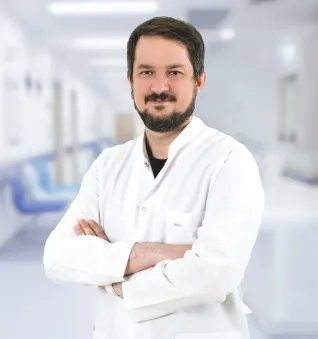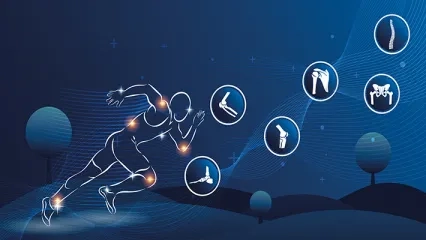Alo Yeditepe
Alo Yeditepe
Big Toes Can Be A Big Problem!
Surgical procedures are complex, and require an experienced surgical team with the proper advanced equipment. Fortunately, we are fully equipped to perform these kind of surgical interventions at Yeditepe University Hospital.
We spoke to Professor of Yeditepe University Hospital's Department of Orthopedics and Traumatology Hallux Valgus (bunions) and Hallux Rigidus (stiff big toe/big toe arthritis) are the most frequent problems impacting on the big toe and the first metatarsophalangeal joint of the foot that links the big toe to the foot.
Hallux Valgus (HV)
A bunion (also referred to as Hallux Valgus) is often described as a bump on the side of the big toe. But a bunion is more than that. The visible bump actually reflects changes in the bony framework of the front part of the foot. The big toe leans toward the second toe, rather than pointing straight ahead. This throws the bones out of alignment-producing the bunion’s “bump”.
Bunions are a progressive disorder. They begin with a leaning of the big toe, gradually changing the angle of the bones over the years and slowly producing the characteristic bump, which becomes increasingly prominent. Symptoms usually appear at later stages, although some people never have symptoms.
Non-visible symptoms, which occur at the site of the bunion, may include pain or soreness, inflammation and redness, a burning sensation, and possible numbness.
Symptoms occur most often when wearing shoes that crowd the toes, such as shoes with a tight toe box or high heels. This may explain why women are more likely to have symptoms than men. In addition, spending long periods of time on your feet can aggravate the symptoms of bunions.
The visible symptom is a protuberance from the side of the foot, often to a degree that can cause significant health and cosmetic problems for the sufferer, as well as being painful. The joint may partially or even totally dislocate (Figures 1 and 2).
HV is one of the most common surgically treated forefoot deformities. And the advanced procedures carried out at Yeditepe University Hospital are a far cry from the first surgical treatment recorded in 1881!
Pain (with or without physical activity), shoe wearing and selection difficulty, limping and problems while walking on uneven ground are common complaints.
In the longer term, this condition can develop to have a severe affect on the other toes and even the entire foot.
Apart from limitingwalking, running, and sportive activities, the condition can make the simple business of choosing and wearing normal footwear extremely challenging
.The deformity prevalence is reported between 12 to 56 %, with a family history of 80 % , most frequently from maternal transmission. It is also more frequent in women.
Many studies about the impact of HV severity on general and foot-specific health-related quality of life have confirmed the condition’s highly negative effect. And that HV surgery has a positive impact effect on the health related quality of life.
There is no known prophylaxis method to prevent the deformity; conservative measures may help only to relieve pain temporarily. On the other hand, surgical procedures are complex, and require experienced surgical team with the proper advanced equipment. Fortunately, we are fully equipped to perform these kind of surgical interventions at Yeditepe University Hospital.
Osteotomies combined with soft tissue procedures are the general preferred surgeries (Figs 5, 6, and 7).
At Yeditepe University Hospital, we discuss the expectations of the patients thoroughly and sympathetically. With appropriate surgical techniques, satisfactory results can be expected.
Hallux Rigidus (Stiff Big Toe/ Big Toe Arthritis)
Hallux Rigidus is a disorder of the joint located at the base of the big toe. It causes pain and stiffness in the joint, and with time it gets increasingly harder to bend the toe. ‘Hallux” refers to the big toe, while “rigidus” indicates that the toe is rigid and cannot move. Hallux Rigidus is actually a form of degenerative arthritis.
Early signs and symptoms include pain and stiffness in the big toe during use, aggravated by cold, damp weather; difficulty with running or squatting, and swelling and inflammation around the joint. As the disorder gets more serious, additional symptoms may develop, including pain, even during rest, difficulty wearing shoes because bone spurs develop, pain in the hip, knee, or lower back due to changes in the way you walk, and in severe cases limping.
The sooner this condition is diagnosed, the easier it is to treat. Therefore, the best time to see a foot and ankle surgeon is when you first notice symptoms. If you wait until bone spurs develop, your condition is likely to be more difficult to manage.
Because Hallux Rigidus is a progressive condition, the toe’s motion decreases as time goes on. In its earlier stage, when motion of the big toe is only somewhat limited, the condition is called “Hallux Limitus.” But as the problem advances, the toe’s range of motion gradually decreases until it potentially reaches the end stage of “rigidus,” in which the big toe becomes stiff, or what is sometimes called a “frozen joint.”
This disorder can be very troubling and even disabling, since we use the big toe whenever we walk, stoop down, climb up, or even stand. Many patients confuse Hallux Rigidus with a bunion, which affects the same joint, but they are very different conditions requiring different treatment.
In some cases, surgery is the only way to eliminate or reduce pain. There are several types of surgery for treatment of Hallux Rigidus. In selecting the procedure or combination of procedures for your particular case, we will take into consideration the extent of your deformity based on the x-ray findings, your age, your activity level, and other factors. The length of the recovery period will vary, depending on the procedure or procedures performed.
If pain and stiffness continue, surgery may be necessary. Shaving the bone spur (cheilectomy) may help relieve
the pain and preserve joint motion. Sometimes it may be necessary to cut the bone (osteotomy) is order to realign or shorten the big toe.
A procedure called interpositional arthroplasty has been successful in younger patients with hallux rigidus. In this procedure, a “spacer” of donor tissue is placed between the ends of the joints to relieve pain. If the condition is severe, arthroplasty or joint fusion (arthrodesis) may be the best option for long-lasting pain relief.
This content was prepared by Yeditepe University Hospitals Medical Editorial Board.
”
See Also
- What are Hip Joint Diseases? Causes and Treatment
- Robotic Hip Replacement Surgery
- Knuckle Cracking Can Be Dangerous When It Becomes a Habit!
- What is Hallux Rigidus (Stiff Big Toe/Toe Arthritis)? Symptoms and Treatment
- What is Hallux Valgus (Bunion)? How is it Treated?
- Meniscus and Cartilage Transplantation Can Be Done at the Same Time
- What Causes Shoulder Dislocation? Shoulder Dislocation Treatment
- Ergonomics in Automobiles Prevents Accidents
- Joint Pain and Causes of Joint Pain
- Walking and Returning to Social Life After Knee Replacement Surgery
- What Are the Advantages of Robotic Knee Replacement Surgery?
- Robotic Knee Prosthesis Surgery
- Why Does Ankle Pain Occur? What Is the Treatment?
- The Usage Area of Robotic Surgery Expands in Orthopedic Surgeries
- Higher Risk of Anterior Cruciate Ligament and Ankle Injury in Female Athletes
- Patients Who Undergo Joint Replacement Surgery Can Stand Up and Walk the Next Day
- Spinal Fractures
- What is Synovitis in Joints?
- Hip Osteoarthritis and Hip Prosthesis
- Hip Impingement Syndrome
- What is the Future of Treating Cartilage Problems?
- Not Only Athletes Suffer from Meniscus Tears!
- Is Cartilage Damage More Common in Those Who Run for Long Periods?
- Beware If Your Shoulder Or Neck Pain Lasts Longer Than Two Days After Swimming!
- Mistakes While Swimming Can Cause Shoulder Pain
- Myths About Fractures
- Vitamin D Deficiency May Be The Cause Of Your Joint Pain
- The First Onset of Pain in Cartilage Damage in the Knee Should Not Be Overlooked
- Have Your Baby Take Their First Steps in Good Health
- Heavy School Bags Can Cause Pain in the Lower Back, Shoulders, and Hands!
- Sports Injuries
- Cartilage Transplantation from Donor Has Been Started to Perform in Turkey
- Working From Home Increases Waist and Neck Problems
- He Walked Out Of The Hospital Where He Entered On Crutches
- First Cartilage Transplant from a Donor
- Pay Attention to the Pain That Occurs in the Front Part of Your Knees While Playing Sports!
- 8 Common Misconceptions About Sports Injuries
- Young Patient Who Could Not Walk Due to Cartilage Damage Recovered With Cartilage Transplantation
- Knee Arthritis
- Knee Pain
- Crunching in the Kneecap May Be a Sign of Calcification
- Injured Athletes Can Return To Sports With Cartilage Transplant
- Treatment of Knee Arthrosis Varies According to the Person
- A Lack of Attention to Sports Injuries in Children May Affect Their Development
Alo Yeditepe





